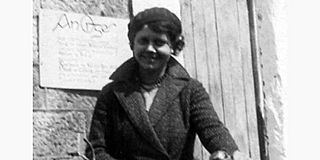Françoise Henry facts for kids
Quick facts for kids
Françoise Henry
|
|
|---|---|
 |
|
| Born | 16 June 1902 Paris, France
|
| Died | 10 February 1982 (aged 79) Auxerre, France
|
| Resting place | Lindry, France |
| Nationality | French |
| Known for | scholar of early Irish art |
Françoise Henry (born June 16, 1902 – died February 10, 1982) was a brilliant French expert. She studied early Irish art, worked as an archaeologist, and was an art historian. She helped us understand ancient Irish treasures. At University College Dublin (UCD), she started a new department in 1965. It was called the Department of History of European Painting. She led this department until she retired in 1974.
Contents
Early Life and Learning
Françoise Henry was born in Paris, France, on June 16, 1902. She grew up in a region called Limousin. Her mother was Jeanne Henry, and her father was René Henry. Her father worked for the French government and was also a writer. He left the family when Françoise was young.
Her grandfather, Charles Clément, was an art writer. He greatly influenced Françoise. She often visited her grandmother near Paris. These visits helped her learn about art.
Françoise went to school at the Lycée Molière in Paris from 1914 to 1920. After that, she studied at two famous places. She graduated from the École du Louvre in 1925. She also graduated from the Sorbonne. At the Sorbonne, she learned from important teachers. She worked as an assistant at a museum. One of her big projects was studying ancient burials. During this time, Henri Focillon, one of her teachers, became a special guide for her.
Her Amazing Career
Françoise Henry first visited Ireland in 1926. She was working on a project about Irish medieval carvings. She was so amazed by the ancient Irish monuments. She especially loved the tall stone crosses at Ahenny. When she went back to Paris, her mentor, Henri Focillon, told her to keep studying Irish carvings.
She earned her special degree on this topic in 1932. In 1933, she published a book called La sculpture irlandaise. It quickly became the main book on Irish sculpture. For several years, scholarships helped her travel and study. She often visited Ireland, Scotland, and parts of Scandinavia. She was part of a group of scholars. They were very interested in Celtic studies. She lived in Trinity Hall when she was in Dublin.
She worked at UCD from 1932 to 1974. Her first job there was in the French department. Her first major book, Irish art in the early Christian period, came out in 1940. This book explored Irish art from ancient times to the 12th century. It covered sculptures, old handwritten books, and metalwork. In the 1960s, this book was made bigger. It became three volumes, first in French, then in English.
From 1934, Françoise taught about European painting. In 1948, she moved to the archaeology department. She became the director of studies there. She worked with other famous scholars. She also worked with many UCD colleagues. She was good friends with people who shared her research interests.
Wartime Efforts
During World War II, Françoise helped protect art. She moved important objects from museums in France and London. She worked as a secretary for a special group. This group saved artworks in areas taken over by war. Later, she worked in a factory in England. From 1944, she drove an ambulance in France. For her brave work, she received a special award. It was called the Legion of Honour in 1947.
After the War
After 1946, Françoise went back to her field work. She recorded ancient monuments. She also helped dig at sites like the Inishkea Islands and Glendalough. Because of her work, the archaeology department at UCD had many photos. These photos showed early Irish Christian art.
Her most famous books were Early Christian Irish art (1954) and Irish high crosses (1964). She also wrote about the Book of Kells (1974). When she retired from UCD in 1974, a special magazine issue honored her. Besides archaeology, Françoise also loved modern art. She helped organize a big art show for Mainie Jellett in 1962. She also advised many art groups. She was on the board of the National Gallery of Ireland from 1962.
In 1949, Françoise Henry made history. She was one of the first four women to join the Royal Irish Academy (RIA). This is a very important group in Ireland. She received special honorary degrees. One was from Dublin University in 1963. Another was from the National University of Ireland. After retiring, she continued to live in both Ireland and France. She passed away in Auxerre, France, on February 10, 1982.
Her Lasting Impact
Françoise Henry's notes and papers are kept in important places. These include the RIA and the UCD Archives. A sculpture of her was made in 1982. It was carved from Cashel sandstone.
A reading room at UCD is named after her. It has a special library for art history. Françoise was also honored in the RIA's Women on Walls exhibition. This project celebrates important Irish women.
In 2016, Françoise Henry was part of the "Women on Walls Project." This project honored the first four women to join the RIA. Other women included were Sheila Tinney, Phyllis Clinch, and Eleanor Knott. In 2017, a special event honored Françoise Henry. An exhibition showed her original notes and drawings. It was called "Françoise Henry and the history of Irish art." In 2018, a lecture about her work was held at the Royal Irish Academy. Her writings and photos are also kept at University College Dublin.
Her many photos are being made digital. This work is done by the Courtauld Institute of Art. It is part of a project called Courtauld Connects.
Images for kids


